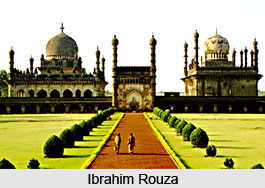 Ibrahim Rouza is one of the famous structures of Bijapur. Built on the tomb of Adil Shah II this mausoleum is famous for its unique grandeur. Popularly known as the `Agra of South India` the city of Bijapur includes some of the splendid structures which can be dated back to 15th - 17th century. The city of Bijapur has been successful in preserving these monuments which are known for the unique designs and royal charm. One such valuable monument is the Ibrahim Rouza which is mainly attractive for the elegant corridors and interconnected buildings which are surrounded with richly decorated walls and perforated windows.
Ibrahim Rouza is one of the famous structures of Bijapur. Built on the tomb of Adil Shah II this mausoleum is famous for its unique grandeur. Popularly known as the `Agra of South India` the city of Bijapur includes some of the splendid structures which can be dated back to 15th - 17th century. The city of Bijapur has been successful in preserving these monuments which are known for the unique designs and royal charm. One such valuable monument is the Ibrahim Rouza which is mainly attractive for the elegant corridors and interconnected buildings which are surrounded with richly decorated walls and perforated windows.
Historically Ibrahim Rouza was built by Ibrahim Adil Shah II for his wife Taj- Sultana. This royal mausoleum included the tombs of Ibrahim Adil Shah II, his wife, his daughter, two sons and his mother Haji Badi Sahiba who were buried in this mausoleum. Ibrahim Rouza is one of the finest historical monuments in Karnataka which exhibits excellent Muslim architecture of the era. Because of its excellent architecture this is one of the well visited sights in Bijapur.
Ibrahim Rouza demarcates an excellent architecture. The mausoleum includes a number of minarets which rise up to a height of 24 metres. It is supposed to be the earliest historical monument which introduced the style of minarets that was adopted in the architecture of Taj Mahal. This monument is also famous for introducing Filigree art within and around the windows of the mausoleum. With its decorative walls and windows this structure introduced the new style of architecture which replaced the old style of engraved inscriptions. While the mausoleums of North India are decorated with inscriptions of Quran, the Mausoleum of Bijapur is decorated with perforated filigree work which continued to remain an important part of Muslim Architecture. The building is further connected with long stretched corridors which have a number of pillars and curvatures that decorate the mausoleum in a unique style. The main mosque is interconnected with other buildings which are equally beautiful and well decorated with the same style of filigree works.
Thus Ibrahim Rouza is one of the most popular sights of tourism in the district of Bijapur in Karnataka. With its elegant architecture and maintenance it attracts the tourists who visit the area to have a close look of fine architecture.



















